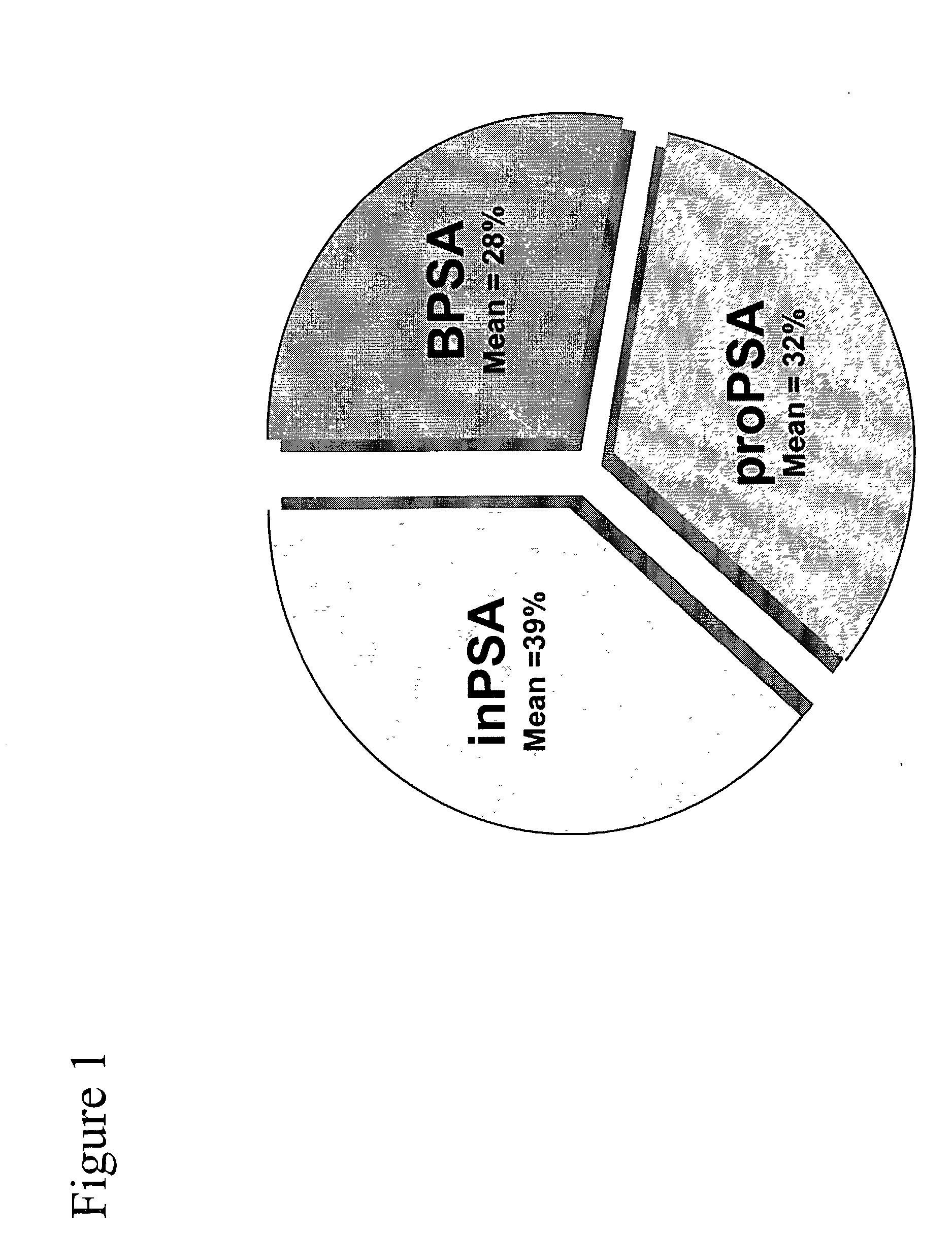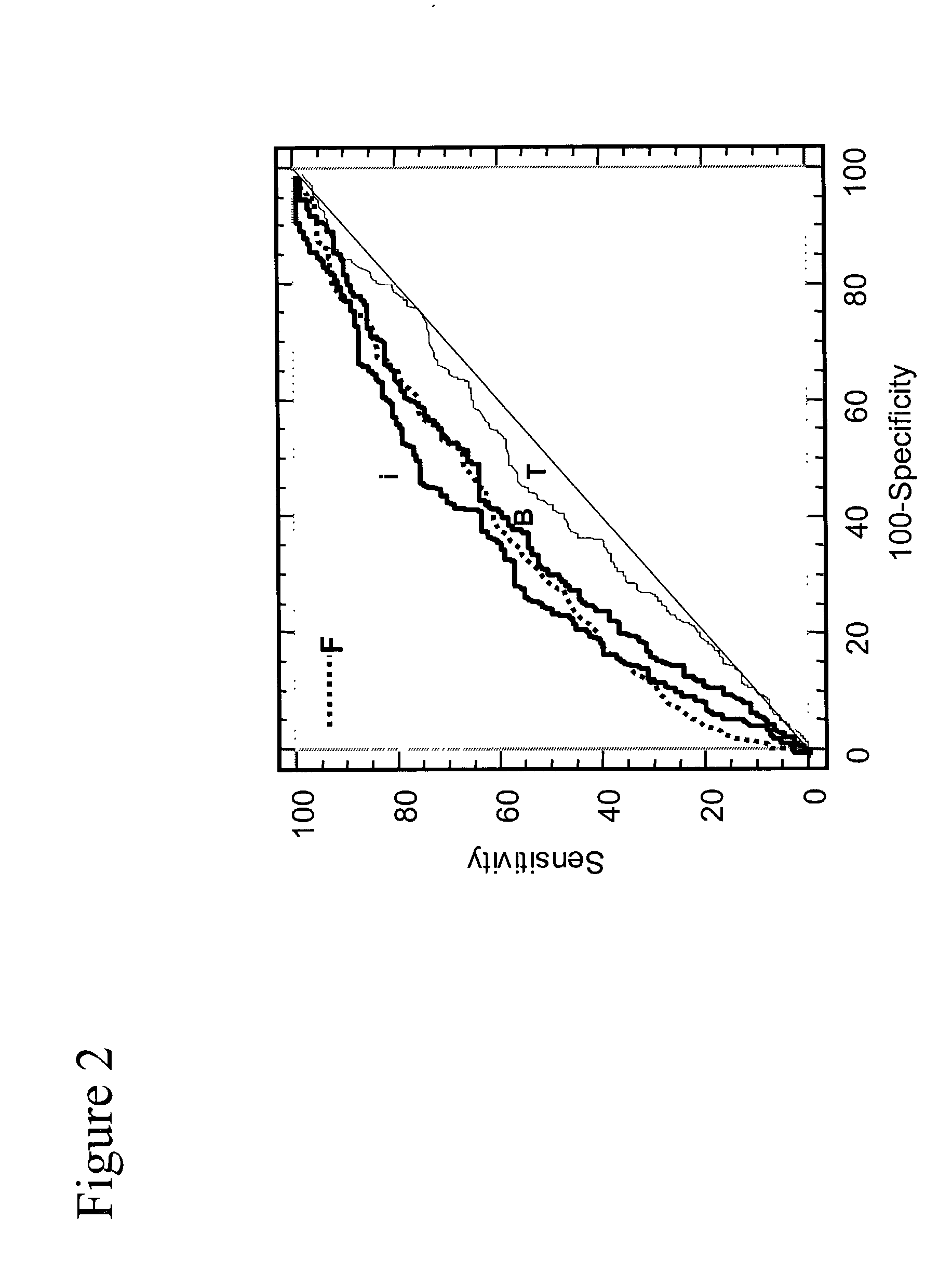Method of analyzing non-complexed forms of prostate specific antigen in a sample to improve prostate cancer detection
a prostate specific antigen and sample technology, applied in the field of prostate cancer detection detection methods, can solve the problems of undefined psa measurement natur
- Summary
- Abstract
- Description
- Claims
- Application Information
AI Technical Summary
Problems solved by technology
Method used
Image
Examples
example ii
Analysis of Serum of Men with Cancer and Benign Disease Containing Total PSA Between 2.5 and 4 ng / ml
[0080] As in Example I, the same series of PSA assays were measured in this cohort of patients who have total PSA values from 2.5-4 ng / ml. The range from 2.5-4 ng / ml is an area where many cancers are present but at a lower occurrence than in the 4-10 ng / ml patients in random screening populations. Total PSA does not discriminate cancer in this range, and current attempts to use % F to improve cancer detection in this range have not shown diagnostic value.
[0081] FIGS. 10 and 11 show that inPSA in the range from 2.5-4 ng / ml is a much better predictor of prostate cancer than free forms of PSA. In FIG. 10, inPSA / pPSA and inPSA minus pPSA give similar AUCs which give a positive discrimination of cancer, whereas F / T give virtually no discrimination of cancer. In FIG. 11, inPSA / [-2]pPSA also gives a positive cancer discrimination whereas free PSA gives little or no cancer discrimination.
[008...
example iii
Analysis of Serum of Men with Cancer and Benign Disease Containing Total PSA Between 2.5 and 10 ng / ml
[0083] The current PSA range for the early detection of prostate cancer is 4-10 ng / ml. It is recommended that men with PSA in this range receive a biopsy to determine if cancer is present. There is discussion in the clinical literature whether to lower the PSA cutoff below 4 ng / ml, possibly to 2.5 ng / ml. In such a case the current diagnostic PSA and free PSA would be used to recommend biopsy unless other improved tests were available.
[0084] FIGS. 12 and 13 inPSA can be used to improve cancer detection over current assays throughout the whole range of 2.5 to 10 ng / ml. In FIG. 12 inPSA / pPSA improves cancer detection over F / T PSA. In FIG. 13 inPSA minus pPSA give an even better improvement compared to F / T PSA. Since F / T PSA is the best PSA diagnostic marker in use today, this indicates that inPSA has significant potential for cancer discrimination.
example iv
Methods of Purifying inPSA and Production of inPSA Antibodies
[0085] Method I: Purifying inPSA After in vitro Incubation of Seminal Plasma with Serum
[0086] Ten ml of seminal plasma was incubated with 50 ml of female serum and incubated for 3 hours at 37.degree. C. This mixture was diluted 1:2 with PBS (phosphate buffered saline, pH 7), filtered through 0.2 micron membrane filters and applied to an immunoaffinity column containing the monoclonal mAb PSM773. PSM773 has been previously demonstrated to bind all forms of free PSA and PSA complexed to ACT. The PSA eluted from the immunoaffinity column was then applied to an S12 size exclusion column and the free PSA eluting as .about.33 kDA was collected. The purified inactive PSA was dialyzed into a buffer consisting of 25 mM Mes, (2-[N-Morpholino]ethanesulfonic acid)), and 40% acetonitrile pH 5.6 (Buffer A) and applied to a 0.8.times.5 cm MA7S cation exchange column (Bio-Rad Laboratories, Hercules, Calif.) equilibrated in buffer A. The P...
PUM
| Property | Measurement | Unit |
|---|---|---|
| Fraction | aaaaa | aaaaa |
| Fraction | aaaaa | aaaaa |
| Fraction | aaaaa | aaaaa |
Abstract
Description
Claims
Application Information
 Login to View More
Login to View More - R&D
- Intellectual Property
- Life Sciences
- Materials
- Tech Scout
- Unparalleled Data Quality
- Higher Quality Content
- 60% Fewer Hallucinations
Browse by: Latest US Patents, China's latest patents, Technical Efficacy Thesaurus, Application Domain, Technology Topic, Popular Technical Reports.
© 2025 PatSnap. All rights reserved.Legal|Privacy policy|Modern Slavery Act Transparency Statement|Sitemap|About US| Contact US: help@patsnap.com



